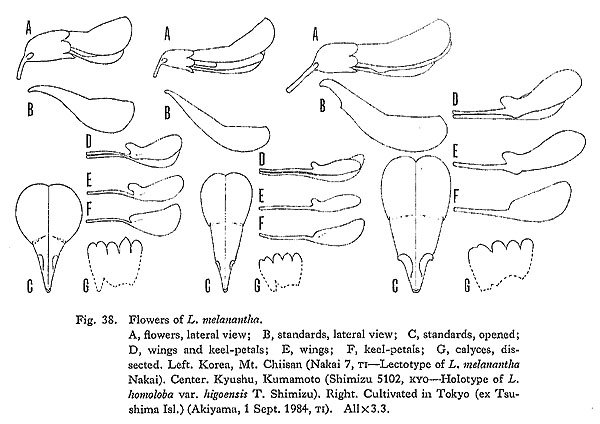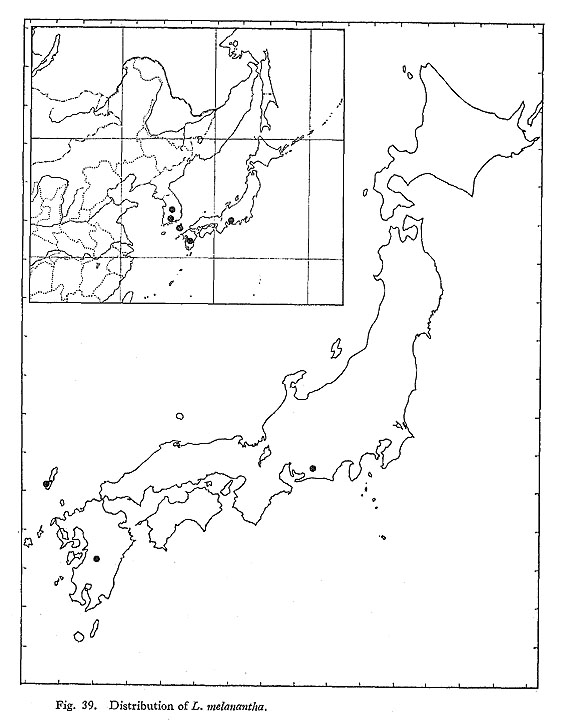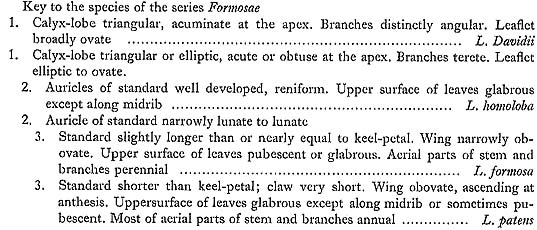Systematic Treatments
L. melanantha Nakai
Lespedeza melanantha NakaiIn Bot. Mag. Tokyo 37: 78 (1923); Lesp. Jap. Korea, 57 (1927).
L. bicolor Turcz. var. purpurea Nakai [ex Mori, Enum. Cor. Pl., 217 (1922), nom. nud.-Nakai in Bull. Nat. Sci. Mus. No. 31, 65 (1952), pro syn. L. melanantha Nakai]. L. melanantha Nakai var. longifolia Uyeki in Journ. Chosen Nat. Hist. Soc. 17: 54 (1934), typum non vidi. L. melanantha Nakai var. densa Nakai in Bot. Mag. Tokyo 49: 349 (1935). L. homoloba Nakai var. higoensis T. Shimizu in Journ. Fac. Textile Sci. Technol. Shinshu Univ. 36, ser. A. 12: 42 (1963); in Acta Phytotax. Geobot. 21: 27 (1964). L. bicolor Turcz. var. higoensis (T. Shimizu) Murata in Acta Phytotax. Geobot. 29: 95 (1978). L. bicolor Turcz. var. melanantha (Nakai) S. Akiyama et H. Ohba in Journ. Jap. Bot. 59: 191 (1984). Japanese name. Kurobana-kihagi (Nakai, 1923). A perennial plant, 0.3-0.5 m high. Stems ascending, 0.5-0.8 cm in diameter; branched in upper parts (a few branches coming from basal part of the stem). Branches terete, ascending or spreading; when young slightly angular with sparsely ascending appressed-sericeous hairs (hairs 0.1-0.2 mm long), later glabrescent; distal parts die in winter season, proximal parts (and the stem) with axillary and adventitious winter buds (winter buds at lower parts mostly dormant). Leaves trifoliolate, petiolate, stipulate, spirally arranged. Stipules free, linear-triangular to linear, 2-5 mm long, brownish, persistent. Petioles 2-4 cm long, nearly glabrous. Rachides 5-10 mm long, similar to the petiole. Terminal leaflets (at middle parts of branches) petiolulate; petiolules 1-2 mm long, swollen; lamina 1.5-2 cm long, 1-2 cm wide, entire, (broadly) elliptic to obovate, round at the base, obtuse or refuse at the apex (the apex itself with or without a point), upper surface nearly gla-brous, lower surface appressed-sericeous (hairs 0.1-0.2 mm long); lateral ones similar to terminal ones but somewhat smaller. Inflorescence axillary racemous, one per axil, 2-5 cm long including the peduncle, loosely 2-6-flowered, peduncles 1-3 cm long, nearly glabrous. Primary bracts ovate, 0.7mm long, nearly glabrous, persistent; secondary bracts similar to primary ones. Flowers ca. 10 mm long at anthesis; pedicels 1.5-3 mm long terete, curved, nearly glabrous. Bracteoles at the base of the calyx broadly ovate to obtuse, 0.2-0.3 mm long, sparsely pubescent outside, glabrous inside, persistent. Calyx 3.0-3.5 mm long, tubulate, slightly four-lobed, sparsely appressed-pubescent; tube ca. 2.5 mm long; lobes subequal in length; lateral ones ca. 0.7 mm long, ca. 0.8 mm wide, semicircular, round at the apex; upper one slightly two-clefted. Standard longer than keel-petal and wings (or nearly equal to wings), keel-petal shorter than (or nearly eqnal to) wings (S≥W>K). Standard dark red-purple inside, paler outside, whitish near the base, obovate, ca. 10 mm long, ca. 5 mm wide, retuse at the apex with or without a point, attenuate at the base without distinct claw, inflexed-auriculate near the base, spreading in anthesis from the part almost 1/2 the way from the base. Wings deeper dark red-purple than standard, ca. 10 mm long with distinct claw: lamina narrowly obovate, ca. 6 mm long, ca. 2.3 mm wide, auriculate at upper basal part, slightly auriculate or tapering at lower basal part; claw ca. 4.0 mm long, whitish. Keel-petal ca. 9 mm long with distinct claw; lamina obovate, ca. 5 mm. long, ca. 2.5 mm wide, paler than wings, deepest in the apical part; claw ca. 4 mm long, whitish. Stamens 10, nearly the same length, ca. 8 mm long, diadelphous. Anthers elliptic, shallowly refuse at the apex, ca. 0.5 mm long, before anthesis yellow. Pistils ca. 8.5 mm long; ovary elliptic, ca. 1 mm long at anthesis, sparsely pubescent, stalked; stalk ca. 1 mm long; style ca. 6 mm long, sparsely pubescent at the basal part, glabrescent at the apical part. Fruits compressed, broadly elliptic, ca. 5 mm long, ca. 4 mm wide, nearly gla-brous. Seeds renifrom, ca. 3 mm long, ca. 2 mm wide. Distr. Japan (Honshu, Kyushu, Tsushima Isl.) and Korea. Representative specimens. Japan. HONSHU. AICHI. Kitashitara-gun, Miwa-mura (Inami, 21 Aug. 1941, TNS; Torii, 26 July 1942, TNS); Miwa-mura, Kawai (unknown collector, 28 Aug. 1940, TNS; Yamamoto in 1943, TUSG). KYUSHU. KUMAMOTO. Kuma-gun, Itsugi-mura, Toji-Tenguiwa (Shimizu 5102, KYO-Holotype of L. homoloba Nakai var. higoensis T. Shimizu); Itsugi-mura, Itagi, Tenguiwa (Oto-matsu 10491, 10492, TI). NAGASAKI. Isl. Tsushima, Mt. Shiratake (cultivated in Tokyo) (Akiyama, 1 Sept. 1984, TI). Korea. KYONGSANGNAM. Mt. Jiri San (Chiisan) (Nakai 7, TI-Syntype of L. melanantha Nakai). CHOLLANAM (ZENNAN). Mt. Pakwoon San (Hakuunzan) (Nakai, 21 Aug. 1934, TI-Holotype of L. melanantha Nakai var. densa Nakai). This species, described from Mt. Jiri San (Chiisan), Korea, is reported from three isolated localities in Japan: Mt. Shiratake (Tsushima Island), Itsuki (Kumamoto Pref., Kyushu), and Mt. Horaiji (Aichi Pref., Central Honshu). It is remarkable that the range of morphological variation among the different localities is very narrow. This species has been regarded as conspecific with L. bicolor Turcz. and often treated as one of its varieties or forms. But it is apparently distinguishable from L. bicolor by the wings, which are longer than the keel-petal, and semicircular calyx-lobes. Forma rosea Nakai in Journ. Jap. Bot. 15: 680 (1939). L. melanantha Nakai var. rosea Nakai in Tyosen-Sanrin-Kaiho No. 122, 25 & 32 (1935), cum diagnos. Jap., nom. illeg. L. bicolor Turcz. var. melanantha (Nakai) S. Akiyama et H. Ohba f. rosea (Nakai) S. Akiyama et H. Ohba in Journ. Jap. Bot. 59: 191 (1984). Japanese name. Beni-kurobana-kihagi (Nakai, 1935), Yakushimahagi (Hort). Corolla red-purple. Ditsr. Sporadic in the range of this species. Specimens examined. Korea. CHUNGCHONGPUK (CHUHOKU). Mt. Zokuri-san (Sackri San) (Nakai 15000, TI-Lectotype of L. melanantha Nakai f. rosea Nakai). Japan. Cultivated in Botanical Gardens, Nikko (Ohba & Akiyama 1038, TI). The typical f. melanantha grows 1 m high or more in Tokyo but this is a dwarf form. This form is cultivated as an ornamental plant in Japan. A plant with dark red-purplish flowers from Mt. Shiratake, Tsushima Islands, was transplanted to Tokyo. The next year the color of the flowers became paler, there-fore the flower color is affected by habitat.
|



